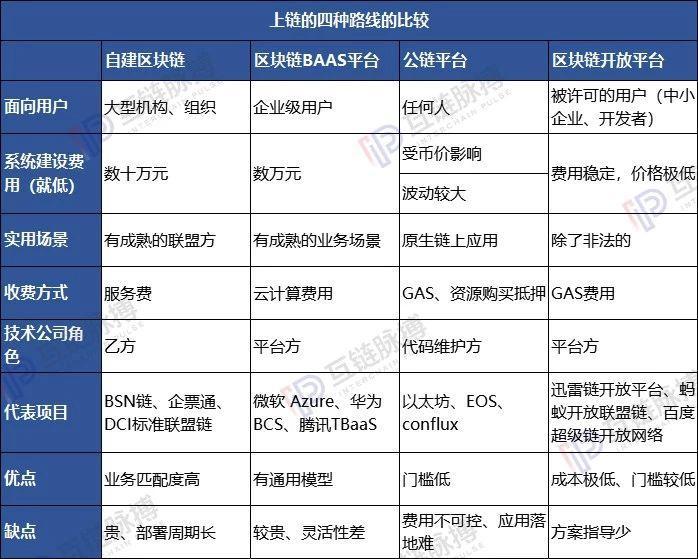The fourth way on the chain-Thunder, Baidu, and Ali build a blockchain inclusive infrastructure one after another
Source: Interchain Pulse
Author: Yuan Shang
Following the release of Xunlei Chain's Open Platform by Xunlei Group in May 2018, in November 2019, Alibaba's ant blockchain started an open beta of the Ant Open Alliance Chain; launched in January 2020 by Baidu "Baidu Super Chain Open Network".
These three products have solved the problems of high on-chain costs and difficult engineering for small and medium-sized enterprises and developers, allowing users of the blockchain to focus on landing applications instead of starting with the underlying technology. This product is between the public chain and the alliance chain, which is more open than the alliance chain, but requires permission to access. In the past blockchain theory circles, there have been expectations of similar products, such as He Baohong, director of the Institute of Information and Communication Technology, said that the "hybrid chain", the director of the China Banking Blockchain Institute said "open license chain" and so on.
- The data of 53 municipal departments in Beijing was launched on the “Directory Blockchain”, and the online data sharing process started simultaneously
- Can I recover my private key? Five minutes to understand V's secret multi-signature recovery scheme
- South Korean officials: Government considers 20% tax on cryptocurrency transactions
The three companies have invariably developed similar products or opened a new path for independent innovation of China's blockchain. Because this product model is currently only concentrated in China.
XAB pattern of blockchain open platform
There are usually three ways to apply blockchain on the chain. One is to build the blockchain system from the bottom; the other is to access a blockchain BaaS platform. The third is to build on a public chain. A DAPP (distributed application).
Until the emergence of the blockchain open platform, there was a fourth route. As regulations in other countries become more stringent, this route may also develop into a global one. It has the physical characteristics of large-scale on-chain, and also meets the regulatory needs of KYC (fully understand your customers) and AML (anti-money laundering).
Of the four methods, self-built blockchain systems are the most expensive. According to the mutual chain pulse, the industry understands that when Chinese blockchain technology companies provide this service, the basic functions will be quoted at 500,000 yuan, at least 100,000 US dollars. Blockchain development companies tailor the blockchain system according to the actual business of the demand side, and some systems also include other supporting technologies such as big data, artificial intelligence, and the Internet of Things. The open period is usually longer.
Those willing to pay for self-built blockchain systems usually have strong organizational capabilities and can coordinate different subjects to reach a blockchain consensus. For example, the BSN chain was initiated by the National Information Center, China Mobile, and China UnionPay. These institutions can gather more alliance members to join by virtue of their industry status. Overseas companies such as IBM provide technical support, and the blockchain shipping platform launched by Maersk has attracted hundreds of alliance members to join.
In comparison, the cost of the blockchain BaaS platform will be cheaper. Traditional Internet technology companies build such BaaS platforms based on cloud products. Generally, the BaaS platform provides some blockchain application templates for users to use, and the charging method also uses cloud computing pricing fees. Depending on the resources used, thousands of tens of thousands of yuan can deploy a blockchain system.
Overseas includes Microsoft Azure, Amazon AWS blockchain, and domestic Huawei BCS and Tencent TBaaS belong to such systems.
Blockchain applications are generated on the public chain, which is also a familiar platform for native blockchain projects, from Bitcoin to Ethereum to the current hundred flowers. The public chain allows anyone to access, objectively it is difficult to meet the needs of supervision. After Ethereum, the charging model of public chains is mainly the consumption of resources by applications. Ethereum is represented by GAS (fuel cost), and EOS is represented by the purchase and mortgage of resources. The pricing methods are tokens issued by various public chains, and illegal coins. As a result, contradictions have arisen. Investors want tokens to fluctuate so that fluctuations can create revenue. Developers want token prices to be stable, and stability can bring cost controllable expectations.
The result of this contradiction of the public chain is the unwillingness to come to the real application. The consensus that the two types of users can reach is the application on pure chains-the tokens issued by the public chain are considered as a stable reference system, and they are all played in a public chain ecology. DEFI has dominated the current public chain applications.
In May 2018, Thunder Chain took the lead in launching an open blockchain platform, creating a new route for blockchain to go on the chain. The biggest difference from the public chain is that the users on the chain need an audit and authentication mechanism, and the contract fees are linked to the fiat currency, and the cost is controllable. The biggest difference from the alliance chain is that, like the public chain, it can quickly deploy blockchain applications. Most of the fees use GAS fees of the public chain, which greatly reduces the cost of the chain. Its approach is similar to that of the public chain. A low-level chain is built, and users can deploy applications on this chain.
Following the Thunderchain open platform, Ant Blockchain and Baidu Super Chain have successively developed similar products. The XAB pattern of the blockchain open platform has been formed (X stands for Thunder; A stands for Ali; B stands for Baidu).

(Tabulation: interlink pulse)
XAB Blockchain Open Platform
In May 2018, Xunlei held a blockchain ecology and new product launch conference in Beijing, and took the lead in releasing the "Xunlei Chain Open Platform". At the press conference, Chen Lei, CEO of Xunlei Group and CEO of Wangxin Technology, said: The launch of the "Xunlei Chain" open platform is to allow enterprises and developers to focus on building blockchain applications without considering the underlying technology of the blockchain.
In November 2019, Ant Blockchain announced in Wuzhen that the "Open Alliance Chain" public beta is aimed at the wider blockchain service network of small, medium and micro enterprises and individual developers.
On January 6 this year, Baidu Super Chain held an online product launch conference and launched the Baidu Super Chain Open Network. The purpose is to enable small and medium-sized enterprises and developers to use blockchain services quickly, cost-effectively, and securely.
It can be seen that these three blockchain open platforms are aimed at low-cost and fast-chain scenarios, and are mainly targeted at small and medium-sized enterprises and developers.
Prior to this, each company had a deep stock of blockchain technology. Through isomorphic multi-chain, Xunlei pioneered the development of a million concurrent blockchain system; both Ant Blockchain and Baidu Blockchain have also developed blockchain architectures that far outperform public blockchains. The similarities of the three blockchain systems are achieved through the side-chain parallel approach to improve throughput. The algorithm specific to each single chain is different, for example, Baidu uses the DAG algorithm.
In terms of node deployment, Xunlei relies on Xunlei distributed computing nodes; Ant Blockchain passes Alibaba Cloud and other trusted nodes. Baidu Super Chain has identified 7 trusted nodes, including Baidu Cloud, Tsinghua University, and iQiyi.
In short, the underlying systems of the three blockchain open platforms far exceed the performance of the public chain, but are as weakly centralized as possible to deploy nodes, which is more credible than many alliance chains deployed on the same cloud.
Of course, as a technology-type open platform, its development friendliness is very important. In terms of development languages, the Thunderchain Open Platform and the Ant Open Alliance Chain are inclined to two languages, C ++ and Solidity. Baidu Super Chain Open Network provides Go language.
In terms of IDE (Integrated Development Environment), both the Thunderchain Open Platform and the Ant Open Alliance Chain are provided. Baidu Super Chain Open Network introduces to Interchain Pulse. It is under development and will be launched in the future with complete development, compilation, debugging, testing and IDE for the deployment process.
In terms of SDK, all three have corresponding SDKs. Ant's and Baidu's are language-based SDKs, and Thunder's are service-based.
In terms of virtual machines, Thunder and Ant are based on the most widely used virtual machines based on EVM and WASM. Baidu provides self-developed XVM.
Although the prices of the three products are far lower than the self-built blockchain and alliance chain BaaS, the Baidu Super Chain open network has an opening fee of 100 yuan, 1 yuan during the test period, 1 dime for deployment contracts, and 0.1 points for calling smart contracts; Thunder Chain is open After exempting the fuel cost for one year, the platform currently charges about 4 cents to call a contract. During the public beta period, Ant gave developers 2 billion fuel costs, but it is not clear what the price will be after the end of the public beta in February.
The other three have professional teams to audit the code quality, which ensures the contract security to a certain extent. The Thunder Blockchain team and the Baidu Superchain team also provide services for the design of the on-chain solution.
According to the survey data of the inter-chain pulse, there are currently more than 10,000 registered users of the Thunderchain open platform, and the ant open alliance chain and Baidu super chain open network have been released relatively late. Currently, more than 1,000 people have been registered.
The three open platforms also have their own advantages and disadvantages. There are fewer application templates for the Thunder open platform. In this regard, there are up to 11 ant open alliance chain templates, which is more convenient for developers. However, Xunlei's products are released early and currently have the most on-chain projects with more than 40. Therefore, the actual on-chain solutions it supports are relatively mature and experienced; there are many ant open alliance chain templates, but the on-chain threshold is very high. Participation The developer even needs to provide a private key. From a language point of view, the solidity 0.4.23 version is also a shortcoming of Ant's products. After all, solidity has reached version 0.6. Baidu Super Chain Open Network has account opening fees, but its underlying chain is very unique and is used for contract Go language, the development threshold is relatively low. 
(Tabulation: interlink pulse)
Blockchain open platform is the contribution of Chinese blockchain companies to the world, and it solves the bottleneck of public chain application. However, such an open platform serves as the infrastructure. Only by waiting for tens of thousands of applications to be brought on the chain, the platform may be able to obtain better economic returns.
This article is the original [Interlink Pulse], the original link: https://www.blockob.com/posts/info/33022 , please indicate the source when reproduced!
We will continue to update Blocking; if you have any questions or suggestions, please contact us!
Was this article helpful?
93 out of 132 found this helpful
Related articles
- Counting mining 2019 | Difficulty of mining increased by 97.67% throughout the year. Which mining pool is on the right pace?
- Cryptocurrency fights for freedom in India's Supreme Court, but opponents see too much risk
- Analysis | The logic behind USDT's continued negative premium
- Dry goods | Full homomorphic encryption resource summary
- About the US folk think tank version of the DCB "digital dollar", you need to know these
- The best activity on the Bitcoin chain for two months, even the handling fee has increased by 89%
- Winter night road, there is light at the end-Babbitt's annual inventory and column author's 2020 outlook





